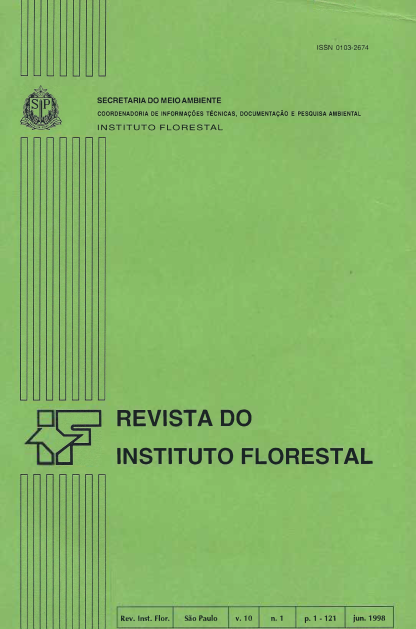RECRUTAMENTO DE PLÂNTULAS DE Genipa americana L. (RUBIACEAE) EM MATA RIPÁRIA
DOI:
https://doi.org/10.24278/2178-5031.1998101536Palavras-chave:
Genipa americana, mata ciliar, germinação, plântulas, recrutamento, regeneração natural, demografiaResumo
O recrutame:nto de plântulas de Geniipa americana L. foi realizado em area de mata ciliar do rio Moji-Guaçu - SP, através da observação e àcompanhamento ao processo em 3 indiv1duos adultos1 mediante amostragem em transecções instalada nas drreçõeA s NO-SE e SO-NE, em parcelas de 4 m 2 , à distancias vanando entre 0 e 30 m do tronco. A partir do início da germinação foram realizadas 54 coletas semanais em que as unidades de acompanhamento foram buquês emergidos dos frutos/sementes. Os resultados foram expressos em tennos da função de densidade, tabela de vida da coorte e relação entre densidade, distância e idade das plântulas, ao longo do ano. Como dados complementares foram levantados, para cada árvore matriz, o diâmetro da copa, sua situação em relação a clareiras e a variaçao de gradiente de luz nas parcelas. Finalmente, Procurou-se indicar as possíveis influências de diferentes condições de luz sobre o estabelecimento. Os resultados mostraram abundância de sementes; germinação maciça; grande intensidade de aeposiçao de frutos a pequenas distâncias da árvore matriz; densidade como restrição ao recrutamento e pequena taxa de sobrevivência, a distâncias situadas além do limite de projeção da copa, sob condições de luz próprias de clareiras pequenas.
Downloads
Referências
AUGSPURGER, C. K. 1983. Seed dispersai of the tropical tree Platypodium elegans, and the scape of its seedlings from frugal pathogens. Journal of Ecology, London, 71 :759-771.
____ . 1984. Seedling survival of tropical tree species: interactions of dispersai distance, lightgaps, and pathogens. Ecology, New York, 65:1705-1712.
BROKAW, N. V. L. & SCHEINER, S. M. 1989. Species composition in gaps and structure of a tropical forest. Ecology, New York, 70(3):538-541.
CANHAM, C. D. 1989. Different responses to gaps among shade-tolerant tree species. Ecology, New York, 70(3):548-556.
CRESTANA, C. de S. M. et ai. 1992. Fenologia , do fruto de Genipa americana L. (Rubiaceac) em mata ciliar do Rio Moji-Guaçu, SP. IPEF, Piracicaba, ( 45):31-34.
CRESTANA, C. de S. M. 1996. Dispersão de frutos/sementes de Genipa americana L. (Rubiaceae) em mata ciliar do Rio Moji Guaçu, SP. Rev. Inst. Flor. , São Paulo 8(2):213-221. ,
CONNELL, J. H. 1971. On the role of natural enemies in preventing competitive exclusion in some marine animais and in rainforest trces. ln: BOER, P. J. den & GRADWELL, G.-R. (eds.) Dynamics of populations. Wageningen, Holland, Centre for Agricultural Publishing and Documentation. p. 298-312
DENSLOW, J. S. 1980. Gap partitioning among tropical rain forest trees. Biotropica, St. Louis, 12: 47-55. (Tropical Succession)
DIRZO, R. & DOMÍNGUEZ, C. A. 1986. Seed shadow, seed predation and the advantages of dispersai. ln: ESTRADA, A. & FLEMING, T. H. (eds.) Frugivores and seed dispersai. The Netherlands, Dordrecht, Dr. W. Junk Publishers. V. 19. p. 237-249.
DUKE, J. A. 1965. Keys for thc identifícation of seedlings of some prominent woody species in light forests types in Puerto Rico. Ann. Mo. Bot. Garden, St. Louis, 52(3):314-350.
DE VUONO, Y. S.; BARBOSA, L. M. & BATISTA, E. A. 1982. A Reserva Biológica de Mogi-Guaçu. ln: CONGRESSO NACIONAL SOBRE ESSÊNCIAS NATIVAS, Campos do Jordão - SP, set. 12-18, 1982. Anais ... Silvic. S. Paulo, São Paulo, 1 6A :548-558. Pt. 1. (Edição Especial)
FENNER, F. 1985. Seed Ecology. London, Chapman and Hall. 15 l p.
HARPER, J. L. & WHITE, J. R. 1974. The demography of plants. Ann. Rev. Eco/. System. 5:419-463.
HOWE, H. F. 1989. Scatter and clump-dispersal and seedling demography: hypothesis and implications. Oecologia, Berlin, (79):417-426.
___ . & WESTLEY, L. C. 1988. Ecological relationships of plants and animais. New York, Oxford University Press. 273p.
JANZEN, D. H. 1970. Herbivores and the number of tree species in tropical forest. The American Naturalist, Chicago, (104):501-528.
LIEBERMAN, D. & LIEBERMAN, M. 1987. Forest tree growth and dynamics at' La Selva, Costa Rica (1969-1982). Journal of Tropical Ecology, Cambridge, 3:347-358.
MARTÍNEZ-RAMOS, M. & ÁLVAREZ-BUYLLA, E. 1986. Seed dispersai gap dynamics and tree recruitment: the case of Cecropia obtusifolia at Los Tuxtlas, Mexico. ln: ESTRADA, A. & FLEMING, T. H. (eds.) Frugivores and seed dispersai. The Netherlands, Dordrechet, Dr. W. Junk Publishers. v. 25. p. 333-346.
PICKETT, S. T. A. 1983. Differential adaptation of tropical specics to canopy gaps and its role conununity dynamics. Tropical Ecology, Varanasi, 24(1):68-84.
PIJL, L, van der. 1982. Principies of dispersai in higher plants. 3ed. Berlin, Springer-Verlag. 214p.
POULSON, T. L. & PLATT, W. J. 1989. Gap light regimes influence canopy tree diversity. Ecology, New York, 40(3):553-555.
SARUKHÁN, J. 1978. Studies of plant demography: Ranunculus repens L., R. bulbosus L. and R. acris L. II. Reproductive strategies and seed population dynamics. Journal of Ecology, London, 62: 151-177.
____ . 1980. Demographic problems in tropical systems. ln: SOLBRIG, O. T. (ed.) Demography and evolution in plant populations. Oxford, England, Blackwell Scientifíc. 219p. (Botanical Monographs, 15)
SCHUPP, E. W. 1990. Annual variation in seedfall, postdispérsal predation and recruitment of neotropical tree. Ecology, New York, 71 (2):504-515.
SORK, V. L. 1987. Effects of predation and light on seedling establishment in Gustúvia superba. Ecology, New York, 68(5): 134 1-1350.
VASQUEZ-Y ÁNES, C. & OROZCO-SEGOVIA, A. 1984. Ecophysiology of seed germination in the tropical humid forests of the world: a review. ln: MEDINA, E.; MOONEY, H. A. & VASQUEZ y ÁNES, C. (eds.). Physiological ecology of plants of the wet tropics. La Haya, Dr. W. Junk Public. p. 37-51.















